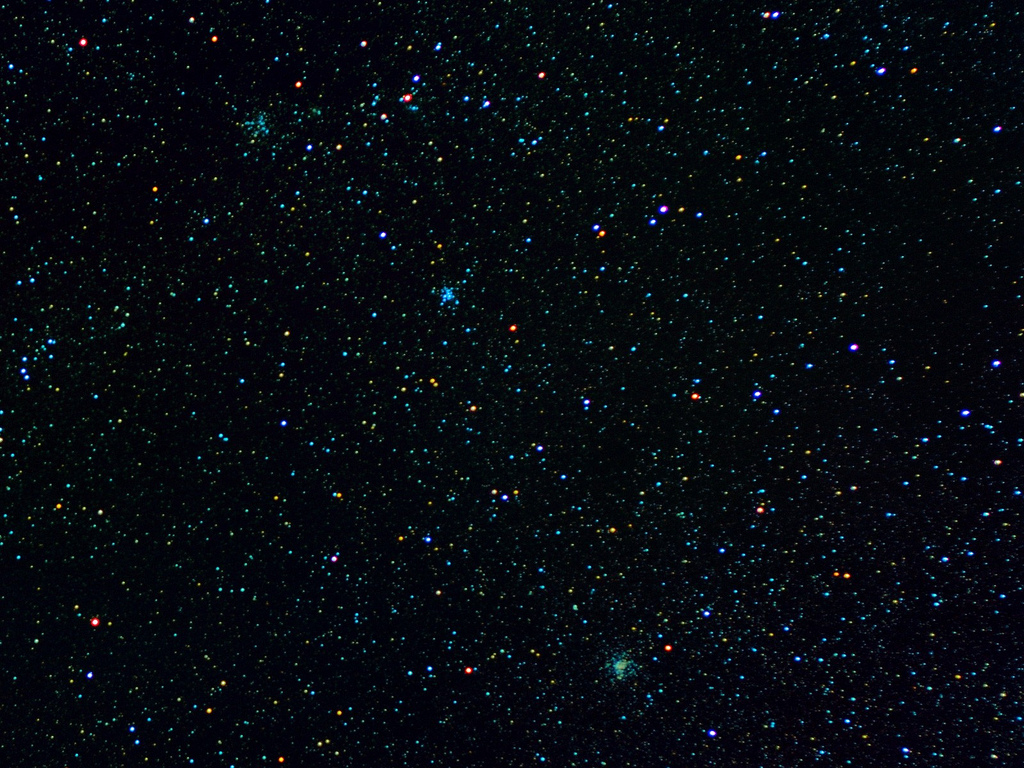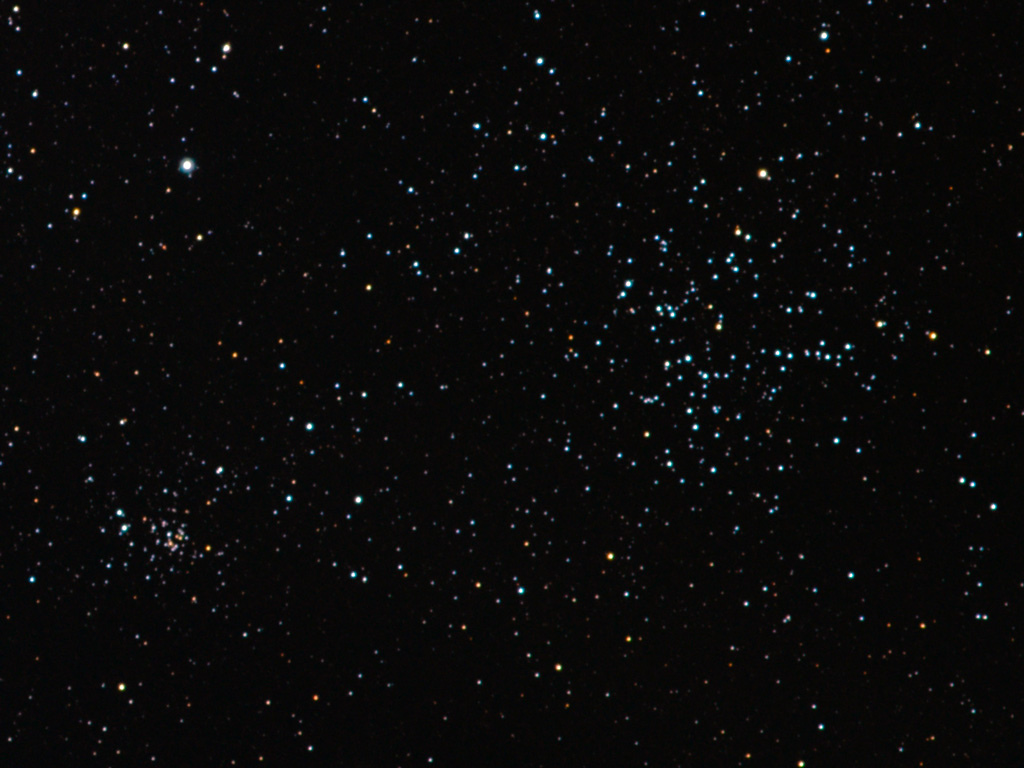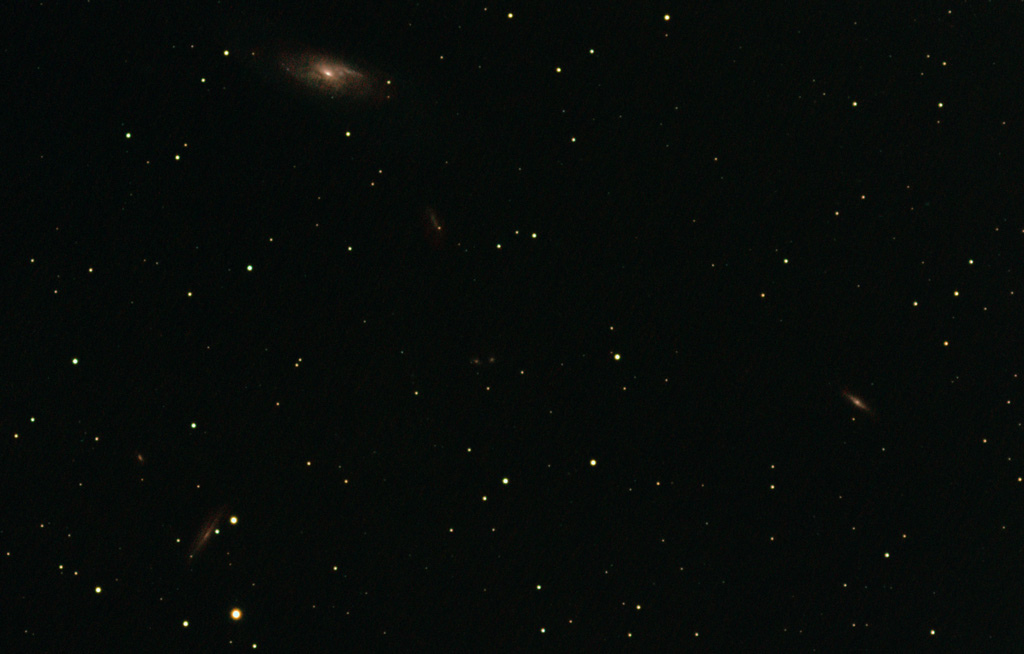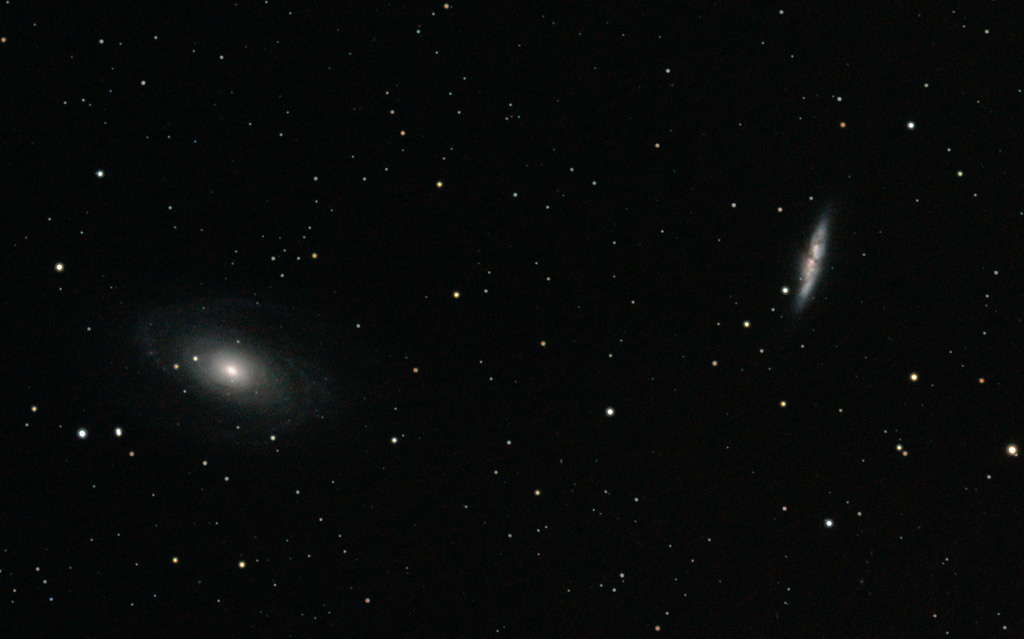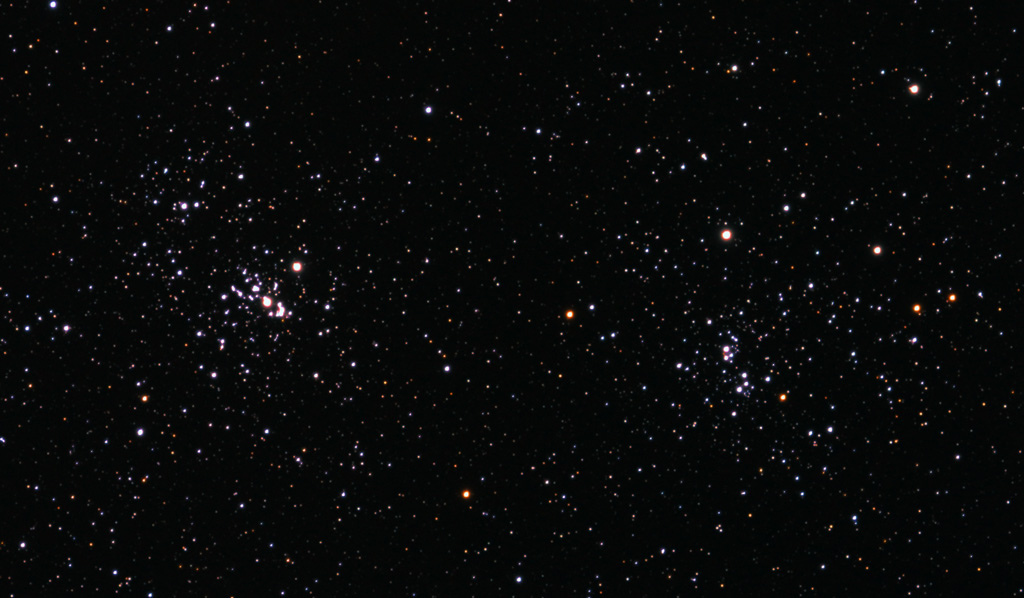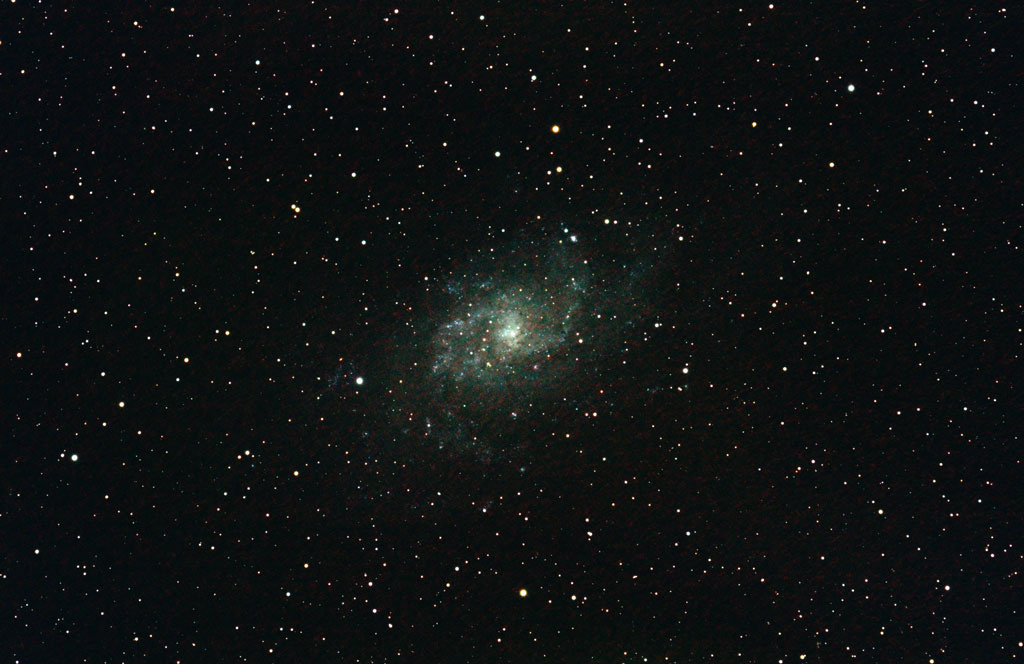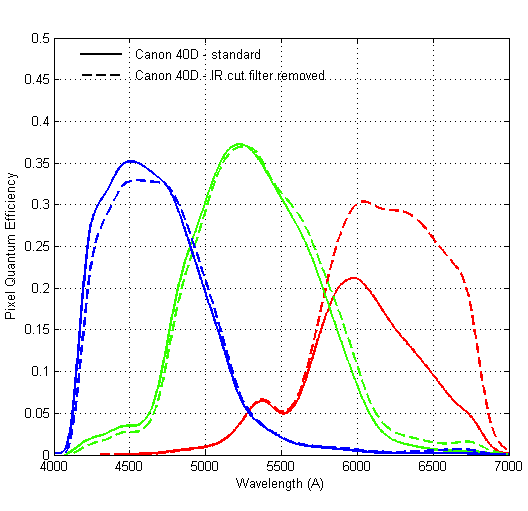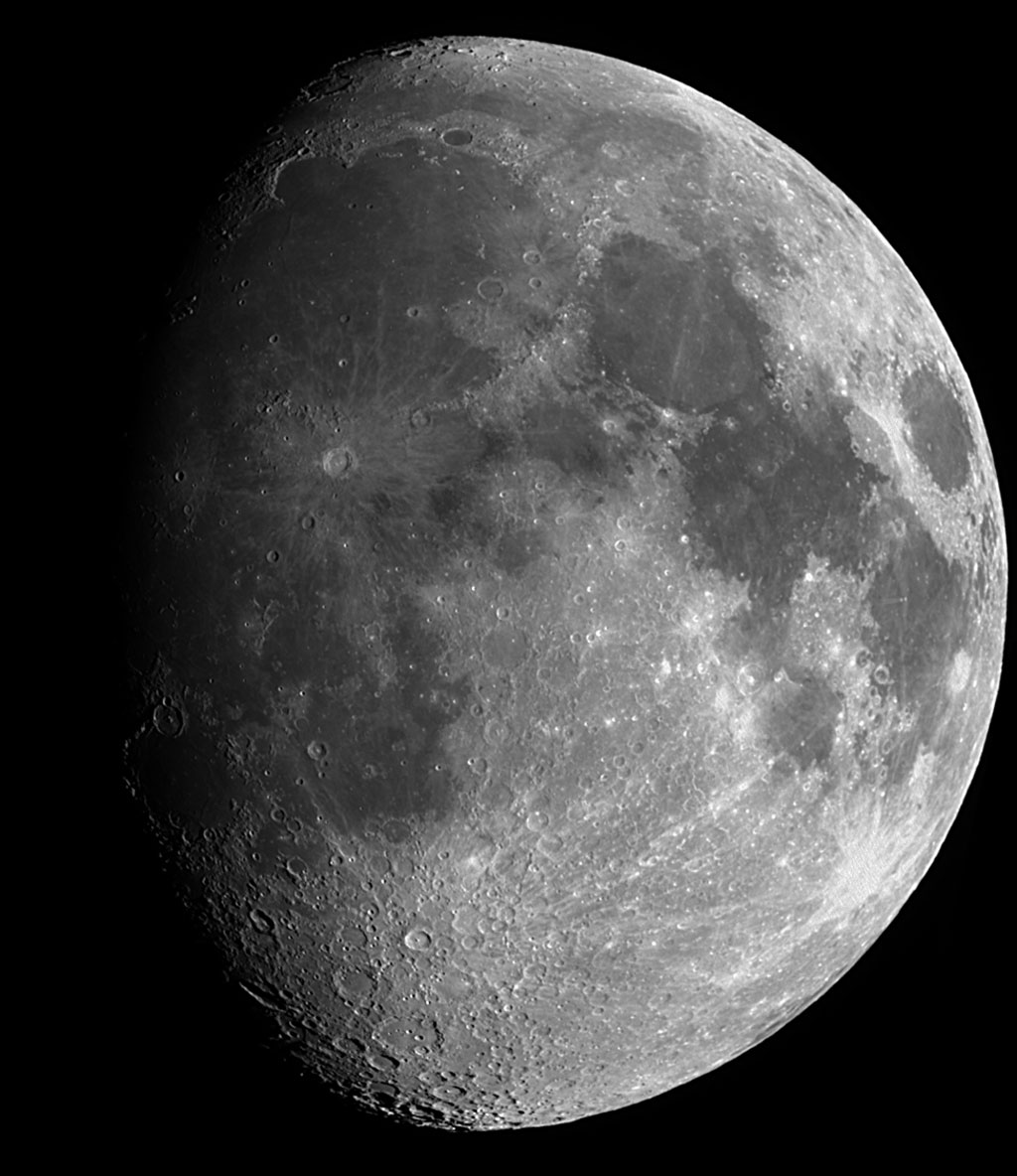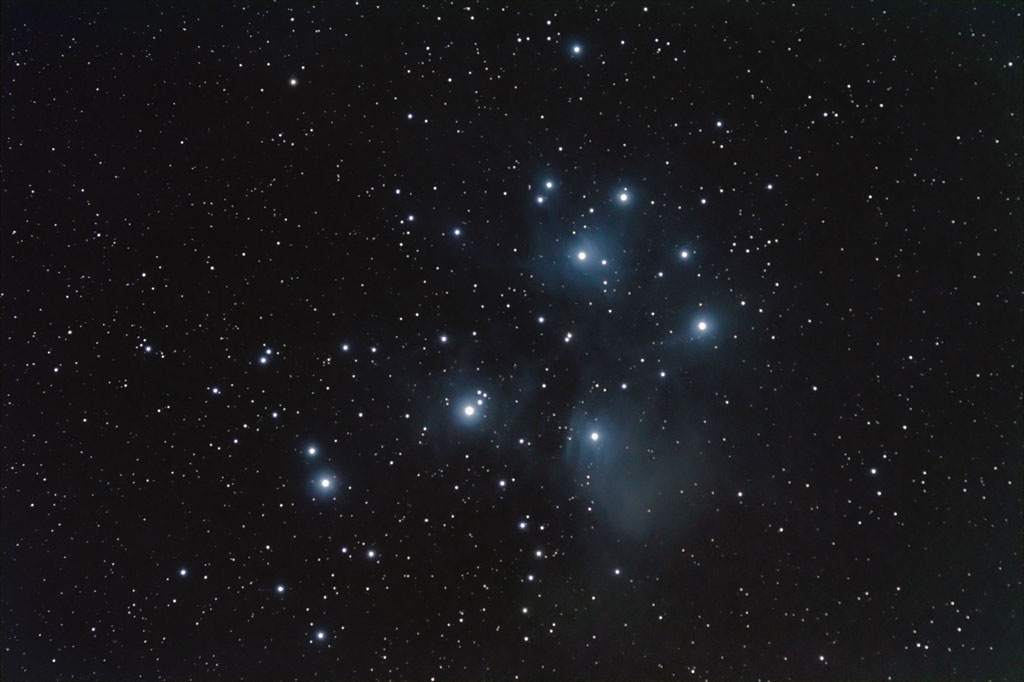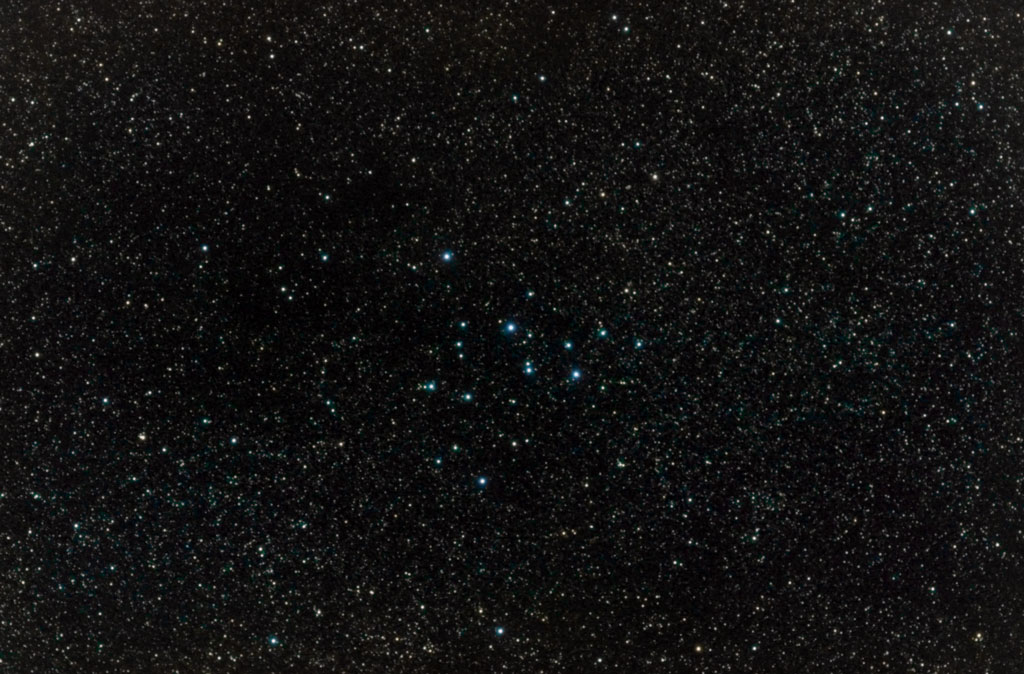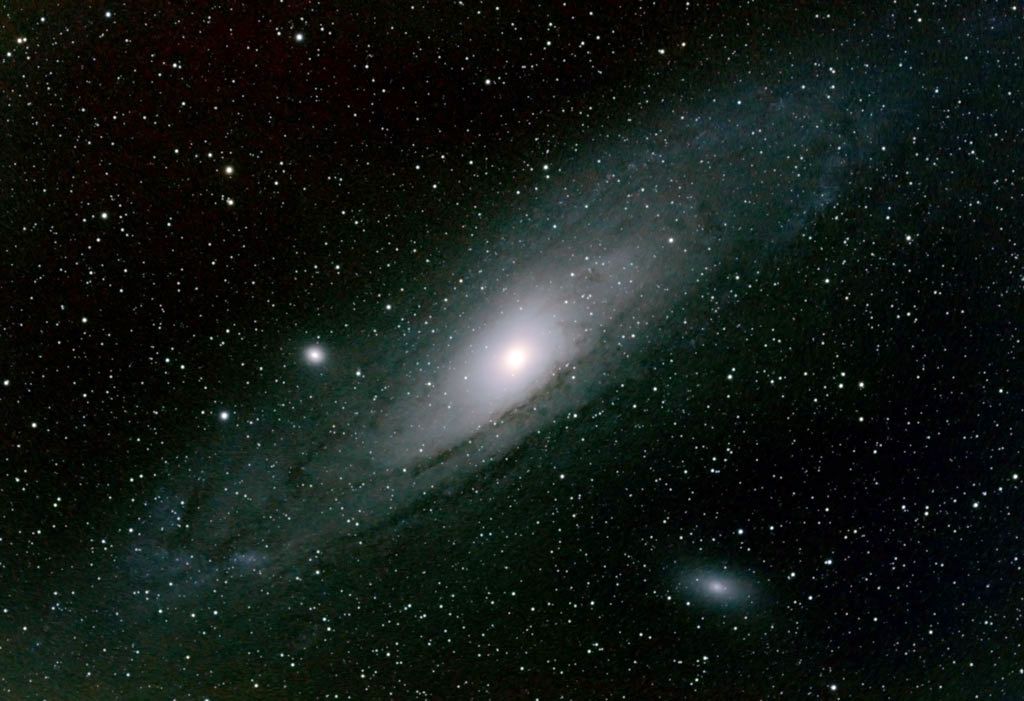The Auriga constellation offers three nice open cluster: M36, M37 and M38 (which I have imaged before). This photograph is the sum of 90 two-minute images taken with a Canon 50mm f/1.8 lens at f/2.8. The image is a crop, and the full field can be seen here:
The one above might not be an exceptional photo, and certainly it’s beyond the limits of my equipment, but I would like you to ponder something. See those galaxies? Forget what they are. Just concentrate on the pixels in the image that make them up.
Each of those pixels, if you will turn a bind eye to the fact that this is a scaled down image, corresponds to a tiny sensor of the CMOS chip of my camera. This tiny sensor, as small as 5 thousandths of a millimeter, is like a bucket. But rather than drops of water, it collects photons.
A photon is the smallest possible amount of light. Trillions hit you every minute. Some of them are absorbed by you, others bounce off and give you color. I didn’t catch many photons in this photograph, because those galaxies are very, very far away. Twenty-five million light-years away.
The journey of each of this photons is incredible, and statistically impossible. Somewhere inside one of the hundred billion stars in one of those galaxies, two hydrogen atoms smashed together at the right angle, under strong forces causes by gravity and, thence, pressure. This small accident, occurred over 25 million years ago, released, among other things, a photon. Our lucky girl. Phoebe the Photon shall be her name.
Phoebe begun her life near the core of her star, and it took her a while to get out. She was bouncing, being absorbed and emitted again an uncountable number of times. Each time she bounced, the direction of her traveling was randomly modified. It took her something between 10‘000 and 100‘000 years to finally endure her last bounce and finally be free of the warm interiors of the star that gave her birth.
It sounds incredible, but of all possible directions in the three dimensions she could’ve taken, Phoebe was headed towards our galaxy! Even more than that, actually: she was headed towards the spot that our galaxy would occupy 25 million years later. She traveled in the near absolute zero cold of the void intergalactic space, and it was a long journey.
How can you believe that of all the places in our galaxy, Phoebe was going to hit our Solar System? And you know, that’s a big place. Compared to the Solar System, the Earth is tiny. It’s tinier than a particularly small grain of sand in a football field. But Phoebe was going there. More than that: for a ridiculous trick of the Universe, she was going to hit the tiny lens of my telescope! Had she come five minutes later or earlier, she would’ve hit the ground next to it. And what are five minutes, when she’s just completed a journey of twenty-five million years?
The lens of the telescope has deflected Phoebe’s trajectory slightly, and sent her off to hit a tiny bucket in the sensor of my camera.
Welcome to Earth Phoebe.
At twelve million light-years away, the M81 and M82 complex makes the farthest object I have photographed so far in my little journey across the cosmos. Poor M82, portrayed on the right, has been utterly misshaped by a close encounter with the much more massive M81, only a few tens of millions light year before the light they emitted reached us earthlings.
We must admit, though, it’s not M81’s fault if it homes a supermassive black hole, alleged to account for 70 million solar masses.
M81 and M81 belong to the M81 group, consisting of 34 galaxies, and being one of the closest groups to our own homely Local Group.
This is my picture of NGC869/884, aka the Double Cluster.
Have you ever fathomed the idea that the corner of the galaxy in which we reside, while not being very poor, is missing some sparkle? The stars around us are pretty dully distributed, to be honest, and although I’m not complaining, we could’ve had it much more interesting. If you were a little green man living on a planet somewhere between NGC869 and NGC884, the two components of the renowned Double Cluster of Perseus, you’d be in for an eyeful.
These two clusters, which are at 6800 and 7600 light-years from us, and yet visible with your bare eyes under dark skies, are only 800 light-years from one another. If you were somewhere in the middle, say 150 light-years from the larger one, how would it appear? Let’s do some math.
The brightest stars there have an apparent magnitude of 7. Their absolute magnitude can be calculated as follows:
$latex 7 - 5(Log(\frac{7000}{3.2616})-1) = -4.65$
where 7000/3.2616 is the distance in parsecs. Let us not calculate the apparent magnitude of such stars as seen from a planet only 150 light-years away:
$latex -4.65 + 5 (Log(\frac{150}{3.2616}) - 1) = -1.33$
Imagine200 stars of apparent magnitude -1.33, spread across an area as large as the Triangulum constellation. The light shining from there would be enough for you to read.
There’s only so much you can do to get good astrophotography when the sky is lousy and your tools are inappropriate, but that makes the whole ordeal more challenging, and the final result, each and every photon collected and carefully placed on each and every pixel, a much more rewarding process.
This latest work of mine, albeit coming with satisfaction, bears nonetheless the burden of a dramatic realization: the unmodded camera naturally offers a varying sensibility in the three color channels: while blue and green let almost all light pass and be collected, the red channel has a very low response, which decreases as the wavelength increases.
Despite this, I made do with what I have and produced a decent picture of what is actually a very faint object. Even though you should be able to distinguish M33, aka the Triangulum Galaxy, with your naked eye in diverted vision from a very dark site, its surface brightness is quite low, it being a decently extended object.
M33 is a galaxy in our own local group, a cosmic neighbor, if you will. And it’s coming over for a visit, approaching us at the steady pace of 24 km/s. It will take quite some time, though, as it is now located at about 3 million light-years away.
If you were on a planet somewhere in M33, on a dark night, and you’d set your gaze upon M31, you’d be astonished. It’s been estimated that the distance between these two neighbors of ours is about 750000 light-years. M31 would then be twice as large and four times as bright if seen from M33! What a show!
We’re still stuck on Earth, but don’t despair: good binocular and a dark sky can offer breathtaking sightings of both M31 and M33.
Nothing much to say about our own satellite, portrayed here as the stacking and processing of 1000 frames captured with my QHY5 camera at the direct focus of my ED80 refractor with a focal length of 600mm.
Since I’m been often talking about the past and the future of the objects I photograph, it’s worth to note that our beloved Moon is slowly but surely receding in its orbit, and sometime in the next few hundred million years, its mission will be accomplished, because it will simply come to the point in which the pull exerted by Mother Earth’s gravity won’t be enough anymore, and our gray companion of some billion years will abandon the cradle, plunging into deeper space, farther and farther away.
It will be a sad day.
I just had a tiny window between a cluster of clouds and the next, so I took a chance at this cluster of stars. The very well known M45, aka the Pleiads, is an object that was identified even at pre-historic times. Homer mentioned it already in 750 BC. It’s formed by some young stars, about 100 million years of age, and it will spread out of existence in about 250 million years.
This photograph is the stacking of 20 images of 5 minutes each.
And that’s what I got after much struggling. Dark frames turned out to be a no go, as I set the computer and the camera to shoot them for the rest of the night while I enjoyed the much deserved sleep, and it turned out that the temperature in the little storage room where I keep my stuff kept rising during the night. Despite the room being outside and not being really that well insulated, the sensor’s temperature went from -12, to -10, to -7, to -4, to -3 and finally reaching -2. All those are centigrade degrees, of course.
Not too bad, I said to myself: forty-six frames ought to compensate for the lack of dark frames, to some extent. Indeed the noise is under control, in the end result.
So let’s mention some interesting factual data about our neighbor, M31, the closest spiral galaxy. Two and a half million light years far, it’s nothing but a stride away. Two-hundred thousand light years across, this beast holds a staggering trillion stars. This mesmerizing amount of stars is scattered in the shape of a ring broken up by interference waves. A spiral galaxy without the spiral arms? That’s correct. The cause of that is M31’s dwarf companion: M32. This tiny galaxy appears to have plunged right through M31 around two-hundred-ten million years ago, while dinosaurs where feasting on each other unaware of all this.
Rushing through the large galaxy, M32 has created a pattern of interference with its gravity, thusly breaking up the spiral arms, which now have settled into a ring.
But M32 is not the only galaxy that M31 is going to cannibalize. Guess who’s next? It’s us. Our own Milky Way and M31 are currently dancing a death dance that will bring the two to a collision in about five billion years from now. Being M31 much larger than the Milky Way, we will become engulfed, cannibalized and assimilated, and our own identity gone forever.

